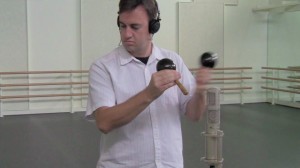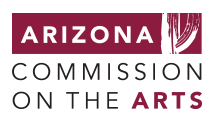The following blog post was written by Katie Selph, currently the Communications Intern at the Arizona Commission on the Arts. She is a recent graduate from the University of Arizona with a degree in Creative Writing.
“With percussion, it’s a very young tradition compared to other instruments like the piano or violin. We have the ability to shape its history.”
Leading up to the application deadline for Fiscal Year 2015 Artistic Research & Development Grants, we’re following up with some of the program’s past recipients. Today, we hear from Fiscal Year 2014 Artist Research & Development Grant recipient, Jeremy Muller.
 Jeremy Muller is a percussionist whose work explores the union of technology and modern performance. Muller received funding in support of his collaboration with three composers on three different compositions. Each composition employed a novel approach or unusual technique: one used ecoacoustics and sounds of the natural world, another involved the use of found objects, and the final piece utilized cutting-edge, interactive technology. We recently contacted Muller to discuss the evolution of these collaborations, as well as his creative process and his interpretation of percussion.
Jeremy Muller is a percussionist whose work explores the union of technology and modern performance. Muller received funding in support of his collaboration with three composers on three different compositions. Each composition employed a novel approach or unusual technique: one used ecoacoustics and sounds of the natural world, another involved the use of found objects, and the final piece utilized cutting-edge, interactive technology. We recently contacted Muller to discuss the evolution of these collaborations, as well as his creative process and his interpretation of percussion.
How did you find the composers you wanted to work with? Did the project lead you to seek them out or did they inspire you to conceive of the project?
I discovered the composers involved in this project by seeing performances of their music. I met two of the composers through mutual friends, having seen colleagues give performances of their music. This encouraged me to further explore their work. I was fascinated by what I heard and I knew I wanted to collaborate with them. I decided to create an overall theme and brought in a third composer to create this project. [Muller’s collaborators on this project were Matthew Burtner, Alaskan-born composer, sound artist and technologist; Alexandre Lunsqui, Brazilian professor of Composition and Theory at Universidade Estadual Paulista; and Cristyn Magnus, composer and music technologist.]
How does working alone compare to working with three unique musicians? How do you negotiate the line between remaining true to your personal vision while remaining open to the input of your collaborators?
 I actually enjoy working alone–it helps me to spend time isolated within my thoughts and to think creatively. I also enjoy collaborating with others because it’s like sharing the “creativity load.” You can bounce ideas off of each other. For my project, I gave each composer general thoughts about what I wanted to do and it allowed them room for their own artistic vision. Sometimes, we would just think aloud to each other no matter what (good or bad ideas), and we would enter into a dialogue where we would find which idea wouldn’t work or discover one that would. It was very satisfying to share your imagination at any particular moment! We already had similar aesthetics, so it was easy to collaborate, while maintaining my own vision. Since we each attached our names to the particular piece of music, we had to trust each other to bring quality and creativity to the project.
I actually enjoy working alone–it helps me to spend time isolated within my thoughts and to think creatively. I also enjoy collaborating with others because it’s like sharing the “creativity load.” You can bounce ideas off of each other. For my project, I gave each composer general thoughts about what I wanted to do and it allowed them room for their own artistic vision. Sometimes, we would just think aloud to each other no matter what (good or bad ideas), and we would enter into a dialogue where we would find which idea wouldn’t work or discover one that would. It was very satisfying to share your imagination at any particular moment! We already had similar aesthetics, so it was easy to collaborate, while maintaining my own vision. Since we each attached our names to the particular piece of music, we had to trust each other to bring quality and creativity to the project.
Your approach to each percussion piece is very different. Have you found yourself more drawn to one approach over the others? While the pieces are created differently, are you finding that there is territory where they overlap?
With percussion, it’s a very young tradition compared to other instruments like the piano or violin. We have the ability to shape its history. My approach is certainly different with each of the composers I’m working with. I believe the overlap happens in that all the composers interplay with science in some form. Some of it is very precise, like the statistical weather data that Matthew Burtner collects for our piece, the amplification of micro-sounds of everyday objects that Alexandre Lunsqui uses in his work, and the artificial intelligence that Cristyn Magnus has developed in her work. I would say that sometimes I am drawn more towards one approach than another, but it really depends on the day. Sometimes I really want to find unique objects as instruments so I’ll be drawn to Alex’s approach, but other times I want to test out the interaction with technology that is Cristyn’s approach. I enjoy them all, but at different times.
How do you find inspiration in the found objects you use for your collaboration with Alexandre Lunsqui? Is it a matter of trial and error, or are you testing objects with a sound in mind? What are you learning about percussion through this experimentation?
Alex speaks about each object as its own character in the piece. This is very true when I realize that each object has certain sound attributes that are unique from another. Some are louder, more expressive, softer attacks, sharper attacks, more sustain, etc. Alex specifies the objects, but I have to try to find the objects that I think will work well as a musical instrument. It really is trial and error, because I’m having to find all my instruments, rather than buying them tuned and polished from a manufacturer. It’s not so much about what I’m learning about percussion, but what audience and I are learning about music: it can be anything and anywhere, and it’s what is perceived by the listener.
One of your compositions deals with interactive technology. What unique challenges are you finding with this approach? Has working in this way changed the way you approach your work more generally?
The difficulty with interactive technology is that it needs to be specific to the instrument and performance space. The composer, Cristyn Magnus, and I have been in close communication while she develops the specific features and then I test them. The process is very similar to developing software. In our case, we are sharing ideas about how the musical content will unfold. Early in the project, we discussed possibilities for musical ideas, but now we’re in the process of testing out the technology. It’s quite different from collaborations where some composers work in isolation and then send the piece to the performer. It’s hard to say whether this has changed my approach to my work or not. I will say, this has had a huge influence on my aesthetic and musical goals. The work I’ve done with Cristyn has sparked my imagination and other ideas I plan to pursue in the future.
You mentioned in your proposal the importance of giving live performances and receiving audience feedback. How has this helped the project grow and evolve? Is there a particular example of a piece of feedback altering the course of the project or changing your thinking about a piece?
 From my point of view, giving a performance of the work is a milestone in the development of the piece. I work towards realizing the music in its entirety and creating a convincing first impression. Often, this experience in itself will intuitively give me a sense of what worked or didn’t work in the piece. I ask myself, “Did a certain section of the composition not work because I didn’t present it well, or is it the way it was written?” Audience feedback gives me a different perspective of the performance that may be difficult for me to see. An audience will not be able to catch every detail and will have a more honest first impression of the work. This is extremely helpful in being able to figure out how to shape the overall work, which can be difficult when I am so involved in the details of the work.
From my point of view, giving a performance of the work is a milestone in the development of the piece. I work towards realizing the music in its entirety and creating a convincing first impression. Often, this experience in itself will intuitively give me a sense of what worked or didn’t work in the piece. I ask myself, “Did a certain section of the composition not work because I didn’t present it well, or is it the way it was written?” Audience feedback gives me a different perspective of the performance that may be difficult for me to see. An audience will not be able to catch every detail and will have a more honest first impression of the work. This is extremely helpful in being able to figure out how to shape the overall work, which can be difficult when I am so involved in the details of the work.
One example that comes to mind is when I was performing a work by Cristyn Magnus. The piece required me to interpret notes that controlled an avatar on screen and certain actions were indicated with audible cues. The combination of my instruments and the computer’s audible cues created the work. When speaking with a few people after the performance, they suggested showing the audience a video of what I was watching on the screen. Since the computer graphics were somewhat primitive and only served a utilitarian purpose, Cristyn and I agreed that it didn’t need to be shown to the audience. I had never considered showing the graphics to the audience, but it did change my thinking about the work: instead of making the visual element the dominant focus; everything was mapped out aurally–thus creating the music, and that is the main idea.
Jeremy Muller received a Bachelor of Music degree from Appalachian State University, a Master of Music from the Cincinnati College-Conservatory of Music and a Doctor of Musical Arts from Arizona State University. He is currently a faculty member at Scottsdale Community College. He frequently gives his own performances, as well as presentations at workshops and master classes across the United States. Many of the works he has written use interactive technology in live performance, and non-traditional, non-western instruments. Bachovich Music Publications, Engine Room Publishing, and Marimba Productions, Inc. have published his compositions and arrangements over the years.
Interested in applying for a Artist Research and Development Grant? Click here for application info and guidelines.
The Artist Research and Development Grant Deadline for FY15 is Thursday September 18, 2014.


